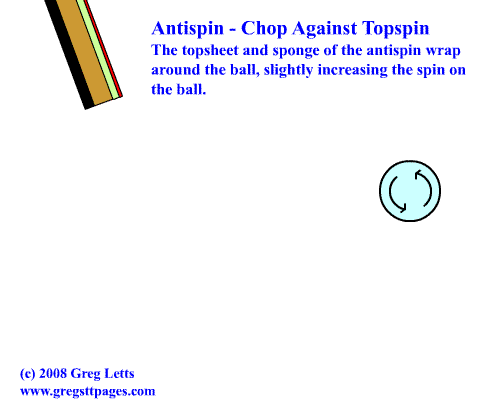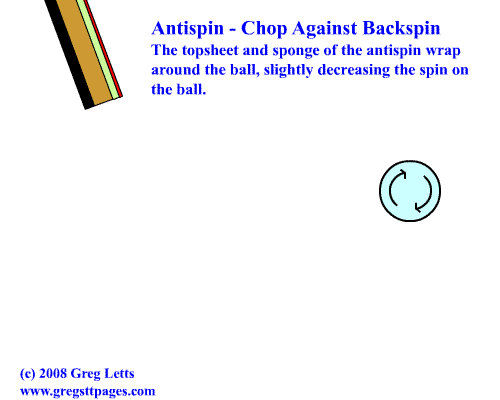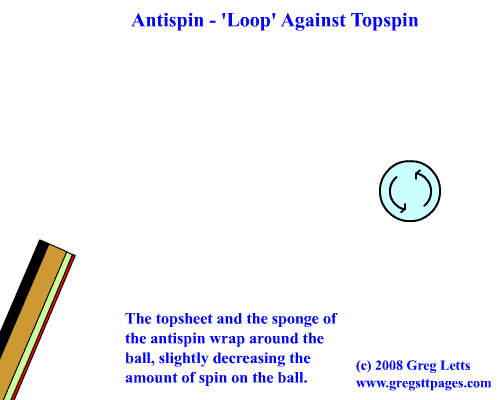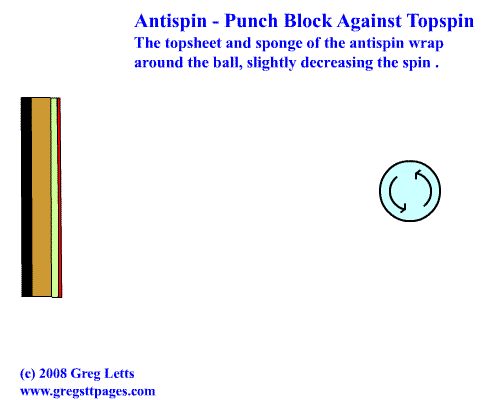OK, before you get settled in to read this article, I’m going to suggest heading off to read my article on How Long Pimples Really Work. Trust me on this – it won’t take long and it will save me having to repeat a lot of the same information twice. Don’t worry, I’ll wait!
10 min later
Welcome back! Now that you have a good idea of how long pimples work, I won’t have to go over all the same things that antispin and long pimples have in common. Instead, we can focus on what’s unique about antispin.
What Is Antispin?
Antispin rubbers are inverted rubbers that are designed to nullify the effects of an opponent’s spin. They generally achieve this by having a relatively slick, slippery surface, that doesn’t grip the ball much. In physics terms, the angle of reflection is pretty close to the angle of incidence – or more simply put, the ball will bounce off your racket at the same angle it came from (not the same path!) – the spin on the ball won’t make much difference.
Antispin has a smooth topsheet for hitting the ball, with the pimples on the inside, instead of the outside. The topsheet can vary from very firm to quite soft. The softer the topsheet, the more it can wrap around the ball, allowing more of the antispin surface to touch the ball.
Since it is an inverted rubber, antispin must also have sponge. These sponges can vary in hardness vs softness, and in the amount of speed they provide. Generally a softer sponge will allow the topsheet to bend more, allowing more of the topsheet surface to touch the ball. A faster sponge will rebound the ball more quickly, allowing less time for the topsheet to be in contact with the ball.
Contact With The Ball – Why Is This Important?
The factors I mentioned above are important because they affect the amount of time the topsheet is in contact with the ball, and the amount of topsheet that will come into contact with the ball. Here’s the important stuff to know:
- Antispins are by nature fairly slippery, but they do have a small amount of grip – which varies from rubber to rubber.
- The more slippery the rubber, the less it can affect the original spin on the ball.
- The more time the topsheet is in contact with the ball, the more chance it has to affect the original spin.
- The more the amount of topsheet is in contact with the ball, the more chance it has to affect the original spin.
So a very slippery, hard topsheet on fast, firm sponge will probably have very little effect on the ball’s spin, simply allowing the spin to continue while changing the direction the ball is travelling in, while a less slippery, flexible topsheet on slow, soft sponge will be able to affect the spin on the ball comparatively more (although still not a lot when compared to normal inverted rubbers though!).
Antispin – Chop Against Topspin
With all that in mind, take a look at the animation below. In all these examples, I’m going to demonstrate what happens when using an antispin with a less slippery, flexible topsheet, on soft, slower sponge. This is the combination that allows you to affect the spin on the ball the most.

Points to note:
- The soft, slow sponge and flexible topsheet allows more of the topsheet to contact the ball, giving you the opportunity to grip the ball a little, and to use that grip to increase the spin on the ball a little.
- Slipperier, stiffer topsheets on faster, firmer sponge will increase the spin much less, tending to simply return the ball back to your opponent with little change in the spin, apart from the reduction due to air friction.
- Just like with long pimples, the spin on the ball going back to your opponent is backspin, which is what he would expect. It probably won’t be quite as much as he expects though, since the antispin won’t grip the ball very much.
Antispin – Chop Against Backspin
Now let’s look at the same chop stroke from you, but against your opponent’s backspin ball.

Points to note:
- In this case, the wrapping of the topsheet around the ball will reduce the spin on the ball a little, but will not reverse the direction of the spin – it does not have enough grip to do that. This is completely different to what would happen using normal inverted rubber.
- Just as with long pimples, this can confuse opponents who don’t know how antispin works. The same shot with normal inverted rubber would change the direction of the spin, returning a backspin ball.
- Again, although the result is opposite to what would happen with a normal inverted rubber, the result is entirely predictable – the antispin will always react the same way.
Antispin – ‘Loop’ Against Backspin
Now let’s reverse the direction of your own stroke, so that you are playing an upward, loop style stroke against your opponent’s backspin ball.

Points to note:
- Again, the wrapping of the topsheet and sponge of the antispin will allow you to increase the spin on the ball a little, but much less than with normal inverted rubber.
- Your opponent will be correct in assuming that topspin is on the ball, but he might misjudge how much spin, since you are adding less spin than a normal inverted rubber would.
Antispin – ‘Loop’ Against Topspin
Now let’s compare what happens when you play a loop type stroke with your antispin against a topspin ball.

Points to note:
- Again, this is similar to what happens when using long pimples, but the antispin will affect the spin on the ball much less. You have not changed the direction of the spin, you have only reduced the amount of spin a little. The stiffer and slipperier the topsheet, and the firmer and faster the sponge, the less effect you will have.
- Just as with long pimples, this can be confusing for opponents. If you had played this stroke with an inverted rubber, you would have changed the direction of the spin from counterclockwise (topspin from your opponent) to clockwise (topspin from you). But instead, the opposite has happened, the ball is still spinning counterclockwise, just a little more slowly.
- Remember, this will happen every time – it’s completely predictable. But first you have to understand what is going on to be able to tell what will happen. Opponents who complain about antispin and long pips either can’t be bothered to learn what is going on, or haven’t had anyone explain what is happening properly!
Antispin – Killing Topspin
Because antispin has a smooth surface, unlike long pips, it can’t kill spin the same way that long pimples do. But it can still have some effect at killing spin. Check out the two animations below.


Points to note:
- First of all, you can forget about pulling this sort of shot off if your topsheet is too hard, and your sponge is too firm. The ball is going to bounce off the rubber before it has a chance to slow anything down.
- Secondly, this is a darn tough shot to pull off successfully. You are almost trying to “catch” the ball with your antispin, giving the ball as much time as possible to stay in contact with the topsheet. Because the topsheet is fairly slippery, the ball will continue to spin on the racket, rather than jumping straight off. But that little bit of friction will still slow down the spin on the ball. Keep in mind that pure air resistance slows the spin on the ball down a lot during the time it takes to travel from your opponent to you. So if you can maximise the contact time with the ball, you have a chance to slow it down even more.
- Thirdly, I must admit that the mechanics of how this works is just a theory of mine – I don’t have scientific proof – I’d need a super high speed camera for that! But I’ve used enough antispin, and played against enough antispin during my career to see the result in action. This is my best explanation for how the effect is achieved.
Conclusion
As you’ve already guessed if you read my article on How Long Pimples Really Work, this part is where I explain that this is only a primer on antispin, and that there is much more to using antispin well than just these basics.
Much of the effect of antispin (and long pimples) is in how you apply the fundamentals, combining antispin with an inverted rubber on the other side to deceive your opponent about what spin you have put on the ball. New antispin users hope that simply contacting the ball with the antispin will do the job – expert antispin players have a number of ways to achieve this deception and get the most from their racket.

